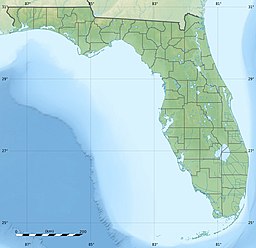Our website is made possible by displaying online advertisements to our visitors.
Please consider supporting us by disabling your ad blocker.
Tampa Bay
| Tampa Bay | |
|---|---|
 Tampa Bay from a NASA satellite in 2006 | |
| Coordinates | 27°45′45″N 82°32′45″W / 27.76250°N 82.54583°W |
| Type | harbor, estuary |
| Primary outflows | Gulf of Mexico |
| Managing agency | |
Tampa Bay is a large natural harbor and shallow estuary connected to the Gulf of Mexico on the west-central coast of Florida, comprising Hillsborough Bay, McKay Bay, Old Tampa Bay, Middle Tampa Bay, and Lower Tampa Bay. The largest freshwater inflow into the bay is the Hillsborough River, which flows into Hillsborough Bay in downtown Tampa. Many other smaller rivers and streams also flow into Tampa Bay, resulting in a large watershed area.
The shores of Tampa Bay were home to the Weeden Island Culture and then the Safety Harbor culture for thousands of years. These cultures relied heavily on Tampa Bay for food, and the waters were rich enough that they were one of the few Native American cultures that did not have to farm. The Tocobaga was likely the dominant chiefdom in the area when Spanish explorers arrived in the early 1500s, but there were likely smaller chiefdoms on the eastern side of the bay which were not well documented. The indigenous population had been decimated by disease and warfare by the late 1600s, and there were no permanent human settlements in the area for over a century. The United States took possession of Florida in 1821 and established Fort Brooke at the mouth of the Hillsborough River in 1824.
The communities surrounding Tampa Bay grew tremendously during the 20th century. Today, the area is home to about 4 million residents, making Tampa Bay a heavily used commercial and recreational waterway and subjecting it to increasing amounts of pollutants from industry, agriculture, sewage, and surface runoff. The bay's water quality was seriously degraded by the early 1980s, resulting in a sharp decline in sea life and decreased availability for recreational use. Greater care has been taken in recent decades to mitigate the effects of human habitation on Tampa Bay, most notably upgraded sewage treatment facilities and several sea grass restoration projects, resulting in improved water quality over time. However, occasional red tide and other algae blooms have caused concern about the ongoing health of the estuary.[1]
The term "Tampa Bay" is often used as shorthand to refer to all or parts of the Tampa Bay area, which comprises many towns and cities in several counties surrounding the large body of water. Local marketing and branding efforts (including several professional sports teams, tourist boards, and chambers of commerce) commonly use the moniker "Tampa Bay", furthering the misconception that it is the name of a particular municipality when this is not the case.[2][3]
- ^ Sampson, Zachary; Weber, Natalie (July 23, 2021). "Red Tide's return raises fears about the health of Tampa Bay". Tampa Bay Times. Retrieved August 30, 2021.
- ^ Craig Pittman (July 7, 2008). "Media found the Rays, lost the 'Bay'". St. Petersburg Times. Archived from the original on June 7, 2011. Retrieved 2010-04-10.
- ^ Guzzo, Paul (November 16, 2022). "Tampa Bay is not the name of a city, locals say. History proves it was". Tampa Bay Times. Retrieved November 16, 2022.
Previous Page Next Page



